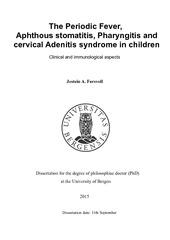| dc.contributor.author | Førsvoll, Jostein Andersen | en_US |
| dc.date.accessioned | 2015-11-04T07:32:44Z | |
| dc.date.available | 2015-11-04T07:32:44Z | |
| dc.date.issued | 2015-09-11 | |
| dc.identifier.isbn | 978-82-308-2562-4 | en_US |
| dc.identifier.uri | https://hdl.handle.net/1956/10625 | |
| dc.description.abstract | Background: The Periodic Fever, Aphthous stomatitis, Pharyngitis and cervical Adenitis (PFAPA) syndrome, first described in 1987, is defined by clinical criteria. With onset during early childhood, the affected children experience short, regular episodes of fever accompanied by at least one of the following clinical signs: aphthous stomatitis, pharyngitis and cervical adenitis. At the beginning of this thesis, very few studies on PFAPA in Scandinavian children had been published, and no population based studies existed. The cause of the syndrome was unknown, although a dysregulation of the immune system was indicated in one study. Curation of PFAPA after tonsillectomy was reported, but the role of the tonsils in the etiology of PFAPA was unclear. Aim: The overall aim of this thesis was to study epidemiological and clinical characteristics of PFAPA in a population based approach, and to study immunological aspects of PFAPA in blood and tonsils. Methods: All children in South Rogaland diagnosed with PFAPA during 2004–2010 were evaluated clinically, and parents were interviewed systematically at the time of diagnosis. A follow-up interview was conducted at least one year after the diagnosis was set. Levels of hematologic parameters, immunoglobulins (Ig) and inflammatory proteins were measured in blood from children with PFAPA during and between febrile episodes and in control children with pneumonia during the febrile phase and at least four weeks after full recovery. Palatine tonsils from children with PFAPA were evaluated histologically, and the number of different cell types in tonsillar germinal centers was identified immunohistochemically. Tonsils from children with tonsillar hypertrophy served as negative controls. Result: In paper I, 46 children (32 boys; p = 0.011) were diagnosed with PFAPA. The median age of onset was 11.0 months (quartiles: 5.0, 14.8). The incidence of PFAPA was estimated to 2.3 per 10 000 children up to 5 years of age. Cervical adenitis, pharyngitis and aphthous stomatitis were present during febrile episodes in 93%, 83% and 46 % of the children respectively. Twenty children experienced spontaneous resolution; median age 60.2 months (range 24–120), and 17 children experienced prompt resolution of febrile episodes after tonsillectomy; median age 50.9 months (range 15–128). In paper II, 22 children with PFAPA and 14 children with pneumonia were included. In children with PFAPA, serum levels of interleukin (IL)-6, CXCL10 and CCL4 were significantly increased during febrile episodes. The levels of IL-6 and CXCL10 were higher in children with PFAPA during the febrile episodes than in children with pneumonia. The levels of CXCL10 were also higher in children with PFAPA between febrile episodes compared to children with pneumonia after full recovery. The total levels of eosinophils and lymphocytes, and the level of CD4+ and CD8+ cells decreased during febrile episodes of PFAPA compared to the afebrile period. Levels of IgA, IgD, IgG and IgM did not differ between children with PFAPA and controls and were within age related normal levels. In paper III, 11 children with PFAPA and 16 children with tonsillar hypertrophy were included. Tonsils from children with PFAPA showed reactive lymphoid hyperplasia dominated by welldeveloped germinal centers with many tingible body macrophages. The histologic findings were unspecific, and a similar morphologic appearance was also found in the tonsils from controls. The number of CD8+ cells in tonsillar germinal centers was significantly lower in children with PFAPA (median 9 cells, quartiles: 5, 15) compared to controls (median 18 cells, 12, 33) (P= 0.001). For the other cell types, no differences were found between children with PFAPA and controls. Conclusions: The incidence of PFAPA was 2.3 per 10 000 children up to 5 years of age. Onset of PFAPA was frequent during the first year of life. The observed pattern of cytokines in children with PFAPA may indicate activation of the innate immune system during the febrile episodes. The decrease in levels of lymphocytes in blood may reflect redistribution of these cells to secondary lymphoid tissue. The lower levels of CD8+ cells in tonsillar germinal centers found in children with PFAPA compared to controls may be a feature linked to the etiology of the disease. | en_US |
| dc.language.iso | eng | eng |
| dc.publisher | The University of Bergen | eng |
| dc.relation.haspart | Paper I: Førsvoll J, Kristoffersen EK, Øymar K. Incidence, clinical characteristics and outcome in Norwegian children with periodic fever, aphthous stomatitis, pharyngitis and cervical adenitis syndrome; a populationbased study. Acta Paediatr. 2013; 102: 187-92. The article is not available in BORA due to publisher restrictions. The published version is available at: <a href="http://dx.doi.org/10.1111/apa.12069" target="blank">http://dx.doi.org/10.1111/apa.12069</a> | en_US |
| dc.relation.haspart | Paper II: Førsvoll J, Kristoffersen EK, Øymar K. Elevated levels of CXCL10 in the Periodic Fever, Aphthous stomatitis, Pharyngitis and cervical Adenitis syndrome (PFAPA) during and between febrile episodes; an indication of a persistent activation of the innate immune system. Pediatr Rheumatol Online J. 2013; 11: 38. The article is available at: <a href="http://hdl.handle.net/1956/7848" target="blank">http://hdl.handle.net/1956/7848</a> | en_US |
| dc.relation.haspart | Paper III: Førsvoll J, Janssen EA, Møller I, Wathne N, Skaland I, Klos J, Kristoffersen EK, Øymar K. Reduced number of CD8+ cells in tonsillar germinal centers in children with the Periodic fever, aphthous stomatitis, pharyngitis and cervical adenitis syndrome. Scand J Immunol. 2015; 82: 76-83. The article is not available in BORA due to publisher restrictions. The published version is available at: <a href="http://dx.doi.org/10.1111/sji.12303" target="blank">http://dx.doi.org/10.1111/sji.12303</a> | en_US |
| dc.title | The Periodic Fever, Aphthous stomatitis, Pharyngitis and cervical Adenitis syndrome in children. Clinical and immunological aspects | en_US |
| dc.type | Doctoral thesis | |
| dc.rights.holder | Copyright the author. All rights reserved | |
| dc.identifier.cristin | 1263284 | |
| dc.subject.nsi | VDP::Medisinske Fag: 700::Klinisk medisinske fag: 750::Pediatri: 760 | en_US |
